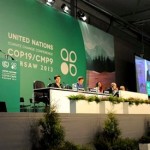Cancun (Mexico) – A landmark assessment, spotlighting the emissions gaps between what nations pledged on climate change 12 months ago and what is actually needed to avoid a 2 degree temperature rise, was formally handed over on December 7 to the Government of Mexico.
The report, coordinated by the United Nations Environment Programme (UNEP) with researchers from 25 climate modeling centres world-wide, has provided a key focus for governments at the UN climate change convention negotiations in Cancun.
Achim Steiner, UN Under-Secretary General and UNEP Executive Director, delivered the report to Juan Rafael Elvira Quesada, the Mexican Environment Minister whose National Institute of Ecology-SEMARNAT was one of the key steering organizations along with the European Climate Foundation.
Minister Elvira highlighted the valuable contribution of the report to the current negotiations at the COP-16. He mentioned that the report “acts as a trigger to promote, at global scale, an increase in our level of ambition to tackle climate change,” and added that “we are only halfway. We have identified and quantified the gap, we want now to continue our collaboration with UNEP on filling this noticeable gap.”
Minister Elvira also asked UNEP to consider follow-up reports including a periodic emissions progress study and one outlining how the gaps between ‘current ambition and scientific reality’ can be bridged by the key date of 2020.
He said Mexico stood ready to back such assessments and reports in support of international efforts to combat climate change. According to scientists, global emissions should be around 44 Gigatonnes (Gt) of CO2 equivalent in ten years time in order to have a good chance of keeping a global temperature rise under 2 degrees C 30 years later.
If all the pledges made at and after the 2009 UN Copenhagen climate summit were met in full, including the financing pledges, emissions might hit 49 Gt leaving a gap of 5Gt of CO2 equivalent that needs to be filled by greater action.
Mr. Steiner said, “The government of Mexico and its scientists has played a key role with other members of the international community in assisting UNEP assess and interpret the complexity of the Copenhagen pledges”.
“The report, which were are proud to hand over today to Minister Elvira today, has provided a reference that can assist governments towards focused action including anchoring here in Cancun promises that could take the world 60 per cent of the way towards what is urgently needed,” he added.
UNEP will now look to assessing how the gap can be bridged including action on short-lived non-CO2 pollutants such as methane, tropospheric ozone and black carbon as compliments to the over-arching challenge of deep cuts on long-lived CO2 emissions.
Several governments, research institutes and initiatives such as the Prototype Methane Financing Facility proposed by The Methane Blue Ribbon Panel are keen to take the opportunity of the up coming UNEP Governing Council/Global Ministerial Environment Forum taking place in Nairobi, Kenya in February to assess the multiple health, agricultural and climate benefits of fast action on non CO2 pollutants as well as creative financing mechanisms to accelerate mitigation.
About the Report
“The Emissions Gap Report: Are the Copenhagen Accord pledges sufficient to limit global warming to 2 or 1.5°C?” is the work of over 30 researchers from 25 centres in countries including Australia, Austria, Belgium, Brazil, China, Denmark, Germany, India, Japan, Mexico, the Netherlands, New Zealand, Switzerland, the United Kingdom and the United States.
It builds on work carried out in the wake of the UN climate change convention meeting in Copenhagen while also assessing the prospects and pathways for the even tougher target of keeping a global temperatures rise to 1.5 degrees Celsius or under over the century.
The report, whose compilation was led by the UNEP Chief Scientist, found that:
- Under a business-as-usual scenario, annual emissions of greenhouse gases could be around 56 gigatonnes of CO2 equivalent by 2020. As a point of reference, global emissions were estimated to be around 48 gigatonnes in 2009;
- Fully implementing the pledges and intentions associated with the Copenhagen Accord could, in the best case identified by the group, cut emissions to around 49 gigatonnes of CO2 equivalent by 2020;
- This would leave a gap of around 5 gigatonnes of CO2 equivalent that needs to be bridged over the coming decade – an amount equal to the emissions of all the world’s cars, buses and trucks in 2005;
- In the worst case identified in the report – where countries follow their lowest ambitions and accounting rules set by negotiators are lax rather than strict – emissions could be as high as 53 gigatonnes in 2020, only slightly lower than business as usual projections.
Source: UNEP.














